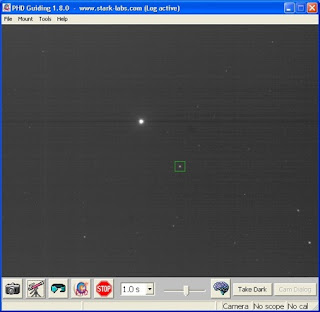
Recently I ran across an article outlining the function of the brain settings in PHD guiding 1.13.0b and I decided to use this as a basis to tweak my setup. The Orion guider is unique because of its short focal length, so some of the parameters will require some adjustment from the stock setup in order to function well. Here is how I set mine up.
RA Aggressiveness - This function determines what percentage of the correction will be applied to the RA axis. The recommendation is to set this setting somewhere between 80 and 100%. I have set mine to 90.
RA Hysteresis - This function applied the correction ahead of time, in anticipation of the correction required based on the history of the correction. The default recommendation is 10 and this is what I have set mine to as well.
Min Motion (pixels) - this is the minimum amount in pixels that the star is allowed to move without correction. The default is 0.15 and it is not recommended to move lower than this, however because I am using a much shorter focal length guide scope, I have lowered this value to 0.10 because a smaller drift on a shorter focal length is equal to a longer drift on a longer focal length. This just tightens up the reaction time.
Calibration step (ms) - this parameter determines the length of the pulse sent to the hand controller to signal changes in movement. This number is also dependent on focal length, shorter is a larger number. I have set mine to 2100 and likely can increase this by 200 more to tighten down on the number of steps needed to do a calibration routine.
Dec Guide Mode - I set mine to Auto
Dec Algorithm - I have set mine to resist switching. This keeps the lash loaded on one side of the mount since all of the drift in declination due to poor polar alignment will always be in one direction. This is a given.
Dec Slope Weight - set mine to 5.00
Max Dec Duration (ms) - this number will vary depending on the quality of your polar alignment. It is not recommended to go over 500 or you have a serious alignment issue. I have set mine at 150
Star Mass Tolerance - setting this to 1.00 turns it off and this is the recommended setting. I have set mine to 0.50
Exposure time - I am finding that limiting mine to 1 second gives me adequate stars to guide with. It is never recommended to exceed 3 seconds on this or all of the corrections will be applied in one axis only. The recommended setting is about 2 seconds because that lies somewhere between the actual error and the correction signals needed to compensate without actually chasing the conditions in the sky so to speak.
I hope this information helps others who are using this particular setup. Your mount may vary as I am applying these corrections to the LXD75 mount via ASCOM and other mounts may react slightly different, particularly in the length of the guide pulse sent to the RS-232 port so be forewarned that you may have to do some tweaking on these settings.












